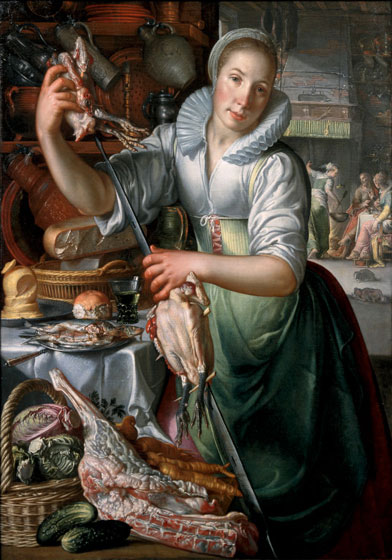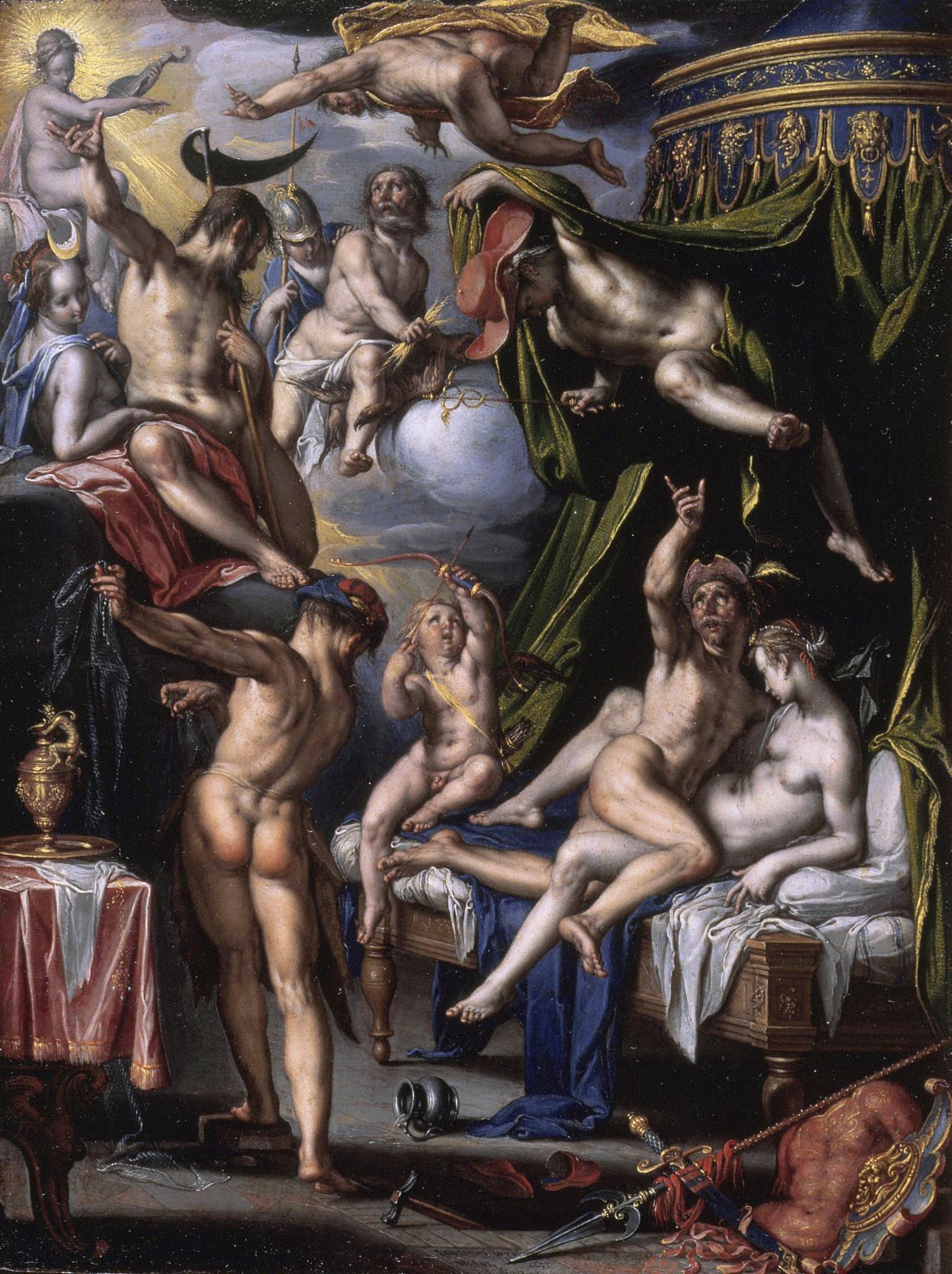
This young lady is not in the least put off by her bloody kitchen work; in fact, she seems to glory in it, doesn't she? Her dead chickens, after all, will soon transform into a lavish feast. The butter is ready and bread and cheese (after all, this is the Netherlands)--and there's the fish on the table, all of it suggesting something extraordinaire in the offing, something of Babette's feast, something almost, well, decadent.
The Kitchen Maid is the work of a Dutch painter with an impossible name, the 16th century mannerist Joachim Wtewael (pronounced eu-oot'-val), known for his expressive use of color (look for yourself) and extravagantly allegorical paintings. His work is featured right now at the National Gallery of Art, in Washington D. C., and was featured on NPR yesterday, where the story itself was a delight.
It seems Wtewael was, oddly enough, quite equally yoked by his piety and his pleasures. In fact, that's what his exhibition of paintings at the National Gallery is titled--Pleasure and Piety: The Art of Joachim Wtewael (1566-1638).
Pleasure and piety are rare bedfellows, of course (a questionable cliche, I know), but are exemplified here in The Kitchen Maid as clearly as the unlikely pairing is in any individual piece in the show. For while what's going on up front here is the beguiling beginnings of what will be a sinfully sumptuous feast, what's going on behind the maid is a story of biblical proportions right out of the gospels here set far out of center stage. Let me try to bring it up close.
Pleasure and piety are rare bedfellows, of course (a questionable cliche, I know), but are exemplified here in The Kitchen Maid as clearly as the unlikely pairing is in any individual piece in the show. For while what's going on up front here is the beguiling beginnings of what will be a sinfully sumptuous feast, what's going on behind the maid is a story of biblical proportions right out of the gospels here set far out of center stage. Let me try to bring it up close.
Now as any 16th century Dutch Calvinist would have realized, the subjects who people this canvas at far, far right are immediately recognizable--well, two of them at least. That's Jesus in red, and that's Mary to his left (a servant is handling the washbasin or whatever), which makes the Kitchen Maid none other than Martha, who seems boldly portrayed in the painting, oddly enough, as a 16th century Rachel Ray.
When she shouldn't be! As anyone who knows the story understands, it's Mary who gets Jesus's attentions and favors, and not Martha, who ends up significantly snarky by way of her sister's shameless adoration of the Master when she (Martha) has to hold down kitchen duty all by her lonesome. There's a moral to the story, of course; but there's also a moral to the painting, but it's not in-your-face. You've got to seek it out, and it has to do with the transient pleasures of earth vs. the eternal treasures of the spirit.
Piety and Pleasure.
And now, the NFSW part. Beware.
Wtewael, who was as doctrinaire a Dutch Calvinist as could be in 16th century Utrecht, a mover-and-shaker, a politician and patrician, seemingly had his wild side. Like others in his school and era, he frequently pursued stories from mythology, actually did three significant canvases of the revealing story of Mars and Venus caught in the act by Vulcan, who was, unfortunately, Venus's husband. In sordid retribution for their wantonness, Vulcan puts the adulterous couple on display for the universe, their loins still commingled coital-ly. Here's Wtewael's version (and he did it thrice!).

Difficult as it may seem, Joachim Wtesael, unpronounceable name or not, was, without a doubt a known and avowed Dutch Calvinist. Go ahead--read that again if you think you're dreaming or I forgot a word or two.

Difficult as it may seem, Joachim Wtesael, unpronounceable name or not, was, without a doubt a known and avowed Dutch Calvinist. Go ahead--read that again if you think you're dreaming or I forgot a word or two.
As curator Arthur Wheelock, Jr., told Susan Stamberg on NPR, ". . .This is what I love about Wtewael: the engagement of all aspects of life--the sensual, the spiritual, religious--all these things are there."
Did I hear an echo there, something familiar, something about "one square inch"?
And then Wheelock says, "It's a fun show--nobody's having a bad time."
Well, I'm sure, as the Church Lady would say.
If you're not going to be in D.C. this summer, have no fear. Pleasure and Piety is coming to Houston soon, and next year to Orange City and Pella, Iowa, as well as Holland, Michigan, on a gala tour of Dutch festivals. Don't miss it.
Here's another--Lot and his daughters, a Bible story (Genesis 19) so NFSW I'll keep the painting in miniature.


No comments:
Post a Comment